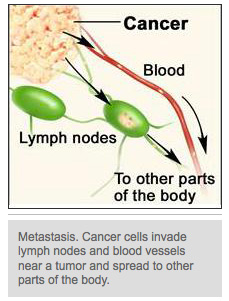What is metastatic cancer?
Metastatic cancer is cancer that has spread from the place where it first started to another place in the body. A tumor formed by metastatic cancer cells is called a metastatic tumor or a metastasis. The process by which cancer cells spread to other parts of the body is also called metastasis.
Metastatic cancer has the same name and the same type of cancer cells as the original, or primary, cancer. For example, breast cancer that spreads to the lung and forms a metastatic tumor is metastatic breast cancer, not lung cancer.
Under a microscope, metastatic cancer cells generally look the same as cells of the original cancer. Moreover, metastatic cancer cells and cells of the original cancer usually have some molecular features in common, such as the expression of certain proteins or the presence of specific chromosome changes.
Although some types of metastatic cancer can be cured with current treatments, most cannot. Nevertheless, treatments are available for all patients with metastatic cancer. In general, the primary goal of these treatments is to control the growth of the cancer or to relieve symptoms caused by it. In some cases, metastatic cancer treatments may help prolong life. However, most people who die of cancer die of metastatic disease.
Can any type of cancer form a metastatic tumor?
Virtually all cancers, including cancers of the blood and the lymphatic system (leukemia, multiple myeloma, and lymphoma), can form metastatic tumors. Although rare, the metastasis of blood and lymphatic system cancers to the lung, heart, central nervous system, and other tissues has been reported.
Where does cancer spread?
The most common sites of cancer metastasis are, in alphabetical order, the bone, liver, and lung. Although most cancers have the ability to spread to many different parts of the body, they usually spread to one site more often than others. The following table shows the most common sites of metastasis, excluding the lymph nodes, for several types of cancer:
| Cancer type | Main sites of metastasis* |
| Bladder | Bone, liver, lung |
| Breast | Bone, brain, liver, lung |
| Colorectal | Liver, lung, peritoneum |
| Kidney | Adrenal gland, bone, brain, liver, lung |
| Lung | Adrenal gland, bone, brain, liver, other lung |
| Melanoma | Bone, brain, liver, lung, skin/muscle |
| Ovary | Liver, lung, peritoneum |
| Pancreas | Liver, lung, peritoneum |
| Prostate | Adrenal gland, bone, liver, lung |
| Stomach | Liver, lung, peritoneum |
| Thyroid | Bone, liver, lung |
| Uterus | Bone, liver, lung, peritoneum, vagina |
| *In alphabetical order. Brain includes the neural tissue of the brain (parenchyma) and the leptomeninges (the two innermost membranes—arachnoid mater and pia mater—of the three membranes known as the meninges that surround the brain and spinal cord; the space between the arachnoid mater and the pia mater contains cerebrospinal fluid). Lung includes the main part of the lung (parenchyma) as well as the pleura (the membrane that covers the lungs and lines the chest cavity). | |
How does cancer spread?
Cancer cell metastasis usually involves the following steps:
• Local invasion: Cancer cells invade nearby normal tissue.
• Intravasation: Cancer cells invade and move through the walls of nearby lymph vessels or blood vessels.
• Circulation: Cancer cells move through the lymphatic system and the bloodstream to other parts of the body.
 • Arrest and extravasation: Cancer cells arrest, or stop moving, in small blood vessels called capillaries at a distant location. They then invade the walls of the capillaries and migrate into the surrounding tissue (extravasation).
• Arrest and extravasation: Cancer cells arrest, or stop moving, in small blood vessels called capillaries at a distant location. They then invade the walls of the capillaries and migrate into the surrounding tissue (extravasation).
• Proliferation: Cancer cells multiply at the distant location to form small tumors known as micrometastases.
• Angiogenesis: Micrometastases stimulate the growth of new blood vessels to obtain a blood supply. A blood supply is needed to obtain the oxygen and nutrients necessary for continued tumor growth.
Because cancers of the lymphatic system or the blood system are already present inside lymph vessels, lymph nodes, or blood vessels, not all of these steps are needed for their metastasis. Also, the lymphatic system drains into the blood system at two locations in the neck.
The ability of a cancer cell to metastasize successfully depends on its individual properties; the properties of the noncancerous cells, including immune system cells, present at the original location; and the properties of the cells it encounters in the lymphatic system or the bloodstream and at the final destination in another part of the body. Not all cancer cells, by themselves, have the ability to metastasize. In addition, the noncancerous cells at the original location may be able to block cancer cell metastasis. Furthermore, successfully reaching another location in the body does not guarantee that a metastatic tumor will form. Metastatic cancer cells can lie dormant (not grow) at a distant site for many years before they begin to grow again, if at all.